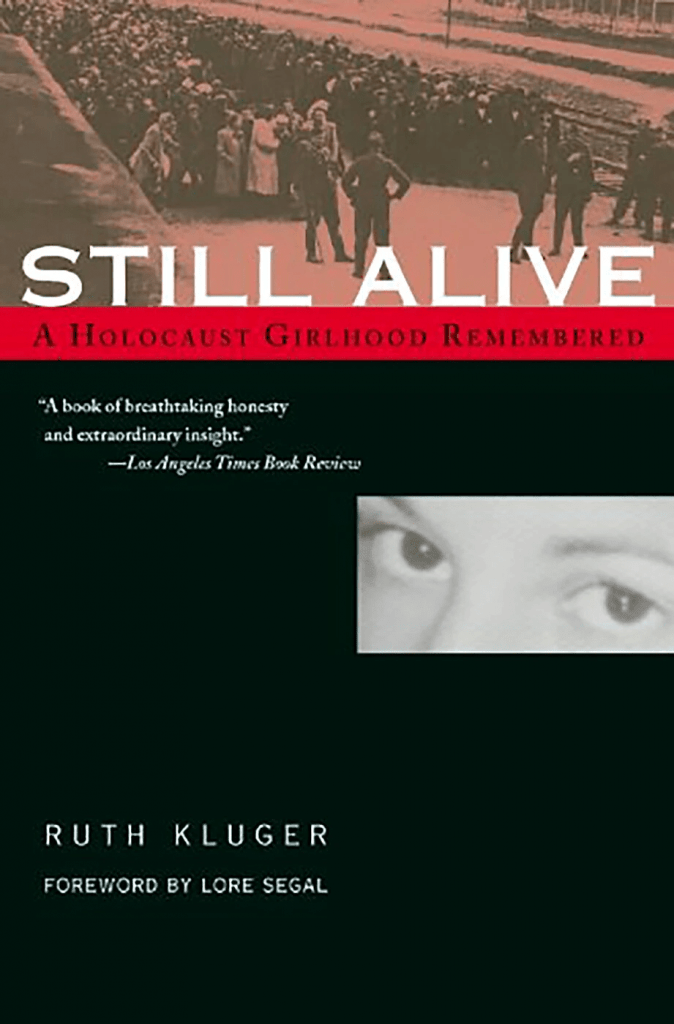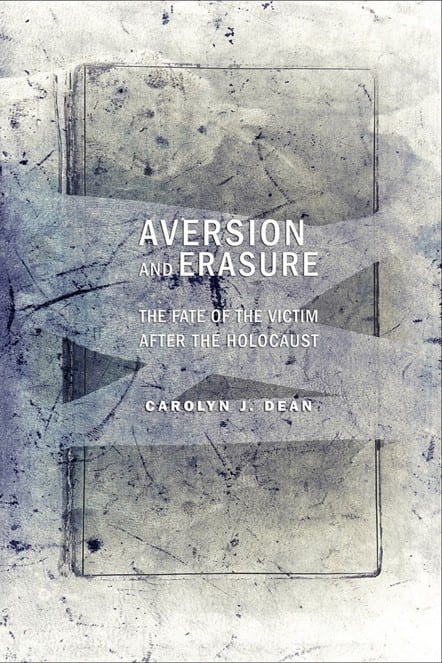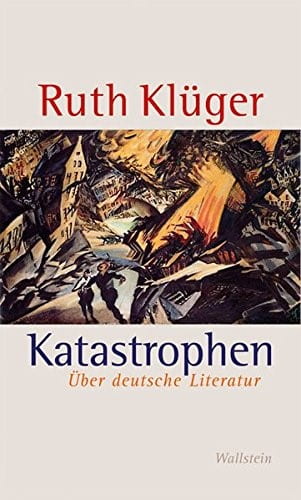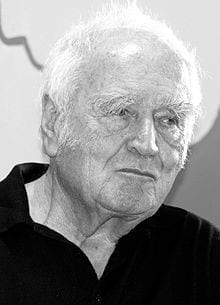By Jonathon Catlin
Last month saw the passing of Ruth Klüger, one of the most influential memoirists of the Holocaust, at age 88. Born to a Jewish family in Vienna in 1931, Klüger was deported to Theresienstadt with her family shortly before her eleventh birthday then transferred to Auschwitz and a women’s subcamp of Gross-Rosen concentration camp. She survived Auschwitz by lying about her age, after a female clerk told her to say she was 15 when she was only 12 in order to be transferred for work in a labor camp. In her memoir, Klüger presents this moment, to which she owed her life, as neither heroic, nor redemptive, but human. “What more do you need for an example of perfect goodness?” (Still Alive,108). Klüger and her mother ultimately survived by escaping from a death march. Her brother and father were murdered. After the war Klüger studied in Regensburg and then in 1947 emigrated with her mother to the United States, where she graduated from Hunter College and went on to earn a Ph.D. in German from Berkeley. She became a professor of German literature and taught at a number of universities, including Princeton (where she became the first female full professor of German) and the University of California, Irvine.
At Irvine, Klüger oversaw a study abroad program in Göttingen, Germany, where she was struck by a bicycle in 1989. As she emerged from a days-long coma, she began to recall long-repressed memories and began to write. As Michael Rothberg writes, “In her reconstruction of her thoughts as the bicyclist bore down on her, the bicycle and headlight are transformed into barbed wire and a spotlight” (130). Klüger’s memoir, Weiter Leben, published in German in 1992 (“German, strange as this statement may sound, is a Jewish language” (Still Alive, 205)), when she was 70, was a bestseller and won major awards. It can be said to exemplify what Freud called Nachträglichkeit, trauma delayed. Rothberg praised her memoir for depicting “a site of extreme violence as a borderland of extremity and everydayness” and described it as a model of a literary mode he termed “traumatic realism,” which breaks through deadlock between “realist” versus “antirealist” Holocaust representation (109).The English version, Still Alive,was published in 2001. The book is widely taught in university courses and is used as an eyewitness testimony in major works of Holocaust historiography including Saul Friedländer’s Nazi Germany and the Jews(1997/2007) and Peter Fritzsche’s Life and Death in the Third Reich(2008).

Klüger stands out among survivors for her outspoken critical stance toward Holocaust remembrance culture. She once said to the German Studies Association, “the present memorial cult that seeks to inflict certain aspects of history and their presumed lessons on our children, with its favorite mantra, ‘Let us remember, so the same thing doesn’t happen again,’ is unconvincing. To be sure, a remembered massacre may serve as a deterrent, but it may also serve as a model for the next massacre” (GSA, 392). She called out Holocaust tourism, asking what the “carefully tended, unlovely remains” of former concentration camps could possibly communicate of the experience of being imprisoned there (Still Alive, 63). “I don’t go to these concentration camp memorial sites,” she once flatly told Der Spiegel, and she even asked the Auschwitz Museum to take down her poems, which were displayed there against her wishes (111). “I don’t hail from Auschwitz, I come from Vienna,” she wrote, and it seems that this attitude led her to opt to have the number tattooed on her arm removed in later life (112). She remained especially critical of German attempts to identify with victims from the Nazi era. “Defeat,” she reflected, “bred its own variants of nationalism”—a kind of negative exceptionalism about German crimes (163).
Writing in the wake of popular milestones like Holocaust (1978) and Schindler’s List (1993), Klüger echoed critics of “the Americanization of the Holocaust” and “the end of the Holocaust,” for whom brutal historical reality was displaced by redemptive and enjoyable kitsch. The problem of this oxymoronic “Holocaust aesthetics” became apparent to Klüger after a young woman approached her at a book signing and said, with a smile, “I love the Holocaust.” Klüger was taken aback. She understood that the woman loved not the event itself, but reading about it. “But her naïve and undisguised pleasure brought up the question: Should she love to read about the Holocaust? Should we in any shape or form feel positive and empowered or cathartically purged when we contemplate the extinction of a people? My impulse was to say to this woman: You shouldn’t. Stop reading these books, including mine, if you enjoy them” (GSA, 393).
This anecdote, Klüger reflects, validates continued discussion of Theodor Adorno’s famous claim that to write poetry after Auschwitz is barbaric, however much one may disagree with it. She worried about Holocaust literature slipping into “kitsch” and reflected about the popularity of Anne Frank’s diary, “it is easier to shed tears over an unfortunate little girl than to agree or disagree with an eminently rational Italian chemist with pronounced opinions that was Primo Levi” (GSA, 400). Telling are the two other survivor authors she praises: the Hungarian Imre Kertész, who reflected on the paradox that once the Holocaust is written about, experience is substituted by the “artefact” of narrative representation, and who was also critical of “Holocaust culture.” She also names the Polish writer Tadeusz Borwoski, whose acerbic This Way to the Gas, Ladies and Gentlemen(1946) she criticizes for its antisemitism and fictional embellishments, while also recognizing “the starkness with which Borowski portrays the slide from indifference to depravity at the edge of human existence and endurance” (GSA, 402).
Still Alive is also notable for its “feminist” discussions of nonconsensual sex work in the camps that debunked popular “whorehouse fantasies” and “a thriving cottage industry” of Holocaust-themed pornography (184), while also problematizing Holocaust “photos as an instrument of sublimated voyeurism” (159). But Still Alive stands out most for its bitter tone. A reviewer wrote thatKlüger “unsentimentally redefined the conventional mythos of the heroic Holocaust survivor,” and indeed she rejected the idea that suffering united victims as “sentimental rubbish.” Instead she challenged her readers to “rearrange a lot of furniture in their inner museum of the Holocaust,” reminding them that “Surviving was not normal. Death was normal.” As the Wiener Zeitung fittingly titled their obituary, Klüger modeled “surviving relentlessly.”
As Klüger’s former colleague Gail Hart reflects, “I think she was a little bit too hard on those who, say, visited Holocaust memorials and Holocaust museums because she said that, you know, they were trying to admire themselves for hating the Nazis.” In Still Alive (as once quoted by Slavoj Žižek), Klüger recounts a conversation with German graduate students in Göttingen:
One reports how in Jerusalem he made the acquaintance of an old Hungarian Jew who was a survivor of Auschwitz, and yet this man cursed the Arabs and held them all in contempt. How can someone who comes from Auschwitz talk like that? the German asks. I get into the act and argue, perhaps more hotly than need be. What did he expect? Auschwitz was no instructional institution…You learned nothing there, and least of all humanity and tolerance. Absolutely nothing good came out of the concentration camps, I hear myself saying, with my voice rising, and [the student] expects catharsis, purgation, the sort of thing you go to the theatre for? They were the most useless, pointless establishments imaginable. That is the one thing to remember about them if you know nothing else. (Still Alive, 65)
Klüger refuses to cast herself as a saint on account of her experience (unlike the canonized but also criticized figure of Elie Wiesel). On the contrary, she even recounts a disturbing incident from the postwar years, while she waited in vain for her father and brother to return from the camps, in which she accidentally killed a little dog by forgetting to turn off the gas in the kitchen where he slept. “Of course I was mortified the next morning when I found his lifeless body and was despondent for days. Accident or symptom? And if the latter, symptom of what?” (Still Alive, 158). This fundamental recognition of moral fallibility led fellow Auschwitz survivor Primo Levi to coin the term “the grey zone” to describe how the camps generated amorality, not morality among victims. Yet while Levi similarly characterized Auschwitz as a “Black Hole,” he also, in sharp contrast to Klüger, called it his “true university” for understanding human nature.
Gabriele Annan spoke for many when she called Klüger “merciless” and “outspoken to the point of aggressiveness”: “She also resents all views on the Holocaust that do not tally exactly with her own, and gets indignant about everyone who criticizes her….Levi told a similar story without making one feel so hectored.” Speaking before Angela Merkel and the German Bundestag on Holocaust Remembrance Day in 2016, Klüger called her own approach “bitter and aggressive,” yet also positively connected her experience with the plight of other groups, praising the “heroic” act of welcoming refugees from war-torn Syria. (She similarly opposed inhumane treatment of asylum-seekers at the U.S.–Mexico border.) Hart, her former colleague, reflects of Klüger, “She is a very direct interrogator. She doesn’t have any of these conciliatory mechanisms that most women have. And she seeks argument. And at first I found that a little bit off-putting and I kind of avoided her.” As Klüger admitted herself, “Damn right. I am hard to satisfy” (Still Alive, 184).

Carolyn J. Dean’s Aversion and Erasure: The Fate of the Victim after the Holocaust (2010) interrogates (sometimes gendered) contemptuous responses to testimonies like Klüger’s—to the point that some of Klüger’s poems “were removed from German-language anthologies of poems from the camps because their desire for vengeance undercut the depiction of an ‘innocent victim worthy of pity’” (AE, 151–2). As Klüger writes in Still Alive, a German newspaper in 1945 to which she submitted her poetry published her poems in an “eviscerated” form that depicted her with “a drawing of a ragged, terrorized child” and reduced her writing to “a maudlin, hand-wringing text, in effect asking the public for pity” (154). Feeling misunderstood partly explains why she waited nearly fifty years to write her memoir—that and wishing not to hurt her mother, whom she describes as a paranoid woman of unsound mind: “in Auschwitz [she was] finally in a place where the social order (or social chaos) had caught up with [her] delusions” (104).
Klüger shatters stereotypes about victims by challenging what Dean calls “the power of particular self-protective, normative rhetorical constructions of victims as modest, reticent (they proclaim their suffering quietly and never angrily), life affirming, or innocent,” a mold that Dean argues “stifles other possible representations, including those prominent in a great deal of victim testimony” (AE, 153). In recurring preferences for testimonies like Levi’s, Dean observes, “again and again…modesty and [the] embrace of ordinary virtues stand in for the veracity of memory” (AE, 53). Dean explains this as a desire to maintain a coherent moral universe, one which preserves a sense of cause and effect, by valorizing self-restraint among victims and excluding abjection and other reactions deemed “excessive” or histrionic.
Klüger writes that for many in the postwar years, being a survivor was a sign of moral degradation: “the Jewish catastrophe was mainly and merely a resounding humiliation to them, not the tragedy of saints and martyrs that our own propaganda has made of it since” (Still Alive, 187). Klüger bristled at some of her readers “mixing up empathy with sentimentality,” being somehow moved by her work but missing what she actually had to say; many already knew what they wanted to hear from Klüger, and she refused to provide it (“Talking to Ruth Kluger,” 245). As Dean shows, such critical preferences often feed mythic notions about victims and can fall back upon narratives about survivors seeking advantages and making “exorbitant” claims to memory and victimhood. What do we lose when abject, angry, or silent, traumatized voices become unhearable to us—erased—and we instead stick to rational, heroic, and redemptive narratives we are primed to hear—often those written by unrepresentative men who survived by having certain advantages in the camps? Dean warns historians that “pursuing one kind of truth may well lead to the neglect of the very voices they seek to recuperate” (Emotions, 409).
Klüger writes that she even felt misunderstood by her longtime friend from university, the famous writer Martin Walser, a German war veteran who “forgets” that she survived Auschwitz, thinking, Klüger muses, that “a concentration camp was something for grown men, not for little girls” (167). This is just one instance of Klüger’s conflicted relationship with Germany and Austria. She calls Walser’s moral failings but beautiful writing “the epitome of what attracts and repels me about his country” (169). The two entered “a conversation…that is still ongoing and will never, can never, have a satisfactory end” (165). “We survivors are not responsible for forgiveness,” she once told reporters in Austria, a country she never ceased to see as antisemitic. “I perceived resentment as an appropriate feeling for an injustice that can never be atoned for.”

Klüger also explored this topic in her scholarly writings. In her book Katastrophen: Über deutsche Literatur(1993), she writes that she approaches the two hundred years between the Enlightenment and the “Final Solution” in which “the Jews were part of German culture” with “the indignation and nostalgia of a latecomer” (7). All she could get hold of was “one last corner” of that tradition, “under which the abyss of the Jewish catastrophe opens up.” She argued in that book that there was still a “Jewish problem” in German postwar literature, criticizing several instances of “Wiedergutmachungsfantasien,” fantasies of reparation for the Holocaust, by making unusually good treatment of Jews appear the norm rather than the exception. “The fulfillment of secret wishes, or the ‘rectification’ of a harsh reality, is certainly one of the therapeutic functions of literature,” she wrote, “but when fantasy presents itself as realism, it becomes by definition kitsch” (13). Such works, she wrote, “create a quasi-reality that shifts what actually happened in the direction of an attempt at rehabilitation for the German population of that time. They hardly overlap with the Jewish memory of the events of those years” (15–16). She thus rejected the popular use of fantasy in postwar German literature to pose the redemptive question, “what would it have been like if people had acted differently?” As she wrote in Still Alive, “The Germans hadn’t lost their hatred and contempt of Jews, but it had become subliminal. What else could you expect? We survivors reminded the population through our mere existence of what had happened, and what they and their people had done” (151).
Klüger urged her readers against “feeling good about the obvious drift of my story away from the gas chambers and the killing fields and towards the postwar period, where prosperity beckons” (Still Alive, 138). The cutting style and substance of Klüger’s writings bar the redemption of the Jewish catastrophe she felt was impertinently expected of her as a survivor. Referring to herself, her mother, and the young woman who survived with them, Klüger wrote, “you cannot deduct our three paltry lives from the sum of those who had no lives after the war….I was with them when they were alive, but now we are separated. We who escaped do not belong to the community of those victims, my brother among them, whose ghosts are unforgiving.”
Jonathon Catlin is a Ph.D. Candidate in the Department of History and the Interdisciplinary Doctoral Program in the Humanities (IHUM) at Princeton University. His dissertation is a conceptual history of “catastrophe” in modern European thought. He tweets @planetdenken.
Featured Image: Daniel A. Anderson, Ruth Klüger, courtesy of UC Irvine.



